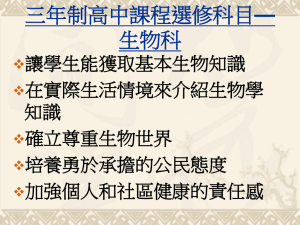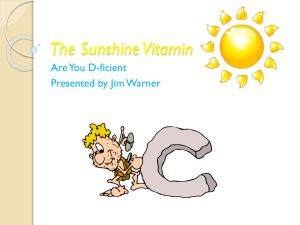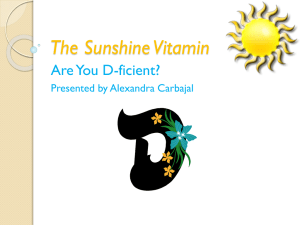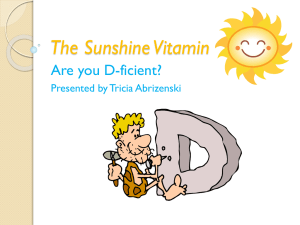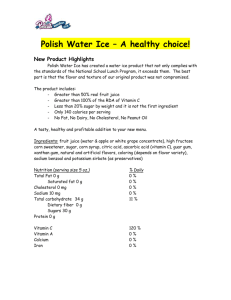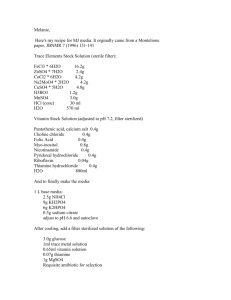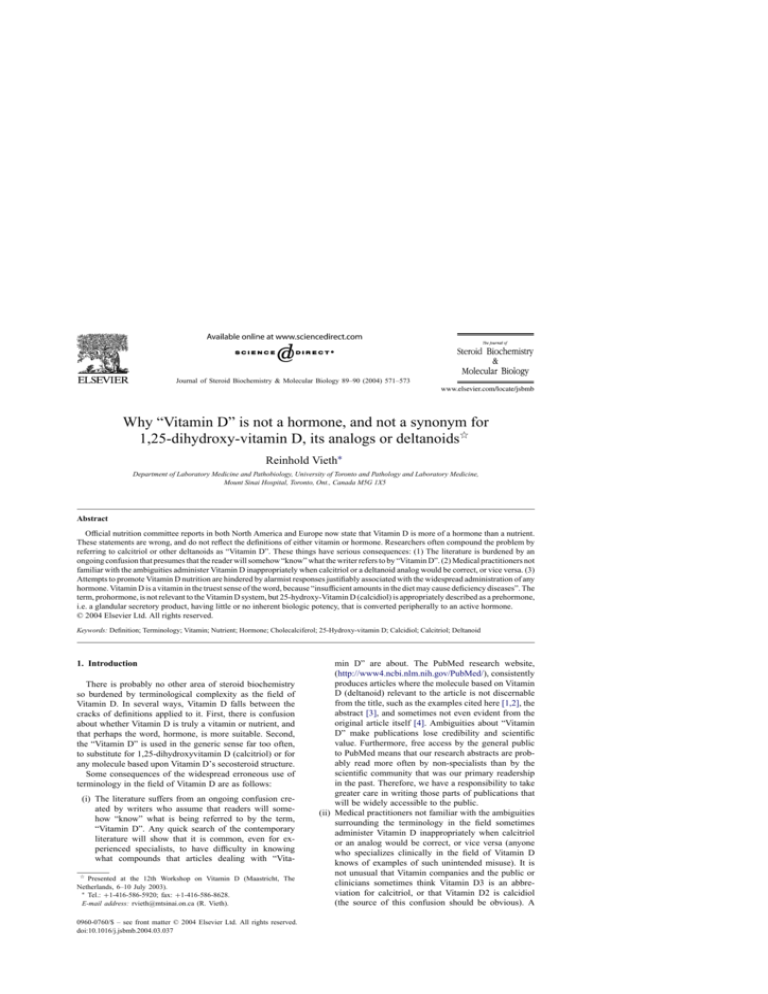
Journal of Steroid Biochemistry & Molecular Biology 89–90 (2004) 571–573
Why “Vitamin D” is not a hormone, and not a synonym for
1,25-dihydroxy-vitamin D, its analogs or deltanoids夽
Reinhold Vieth∗
Department of Laboratory Medicine and Pathobiology, University of Toronto and Pathology and Laboratory Medicine,
Mount Sinai Hospital, Toronto, Ont., Canada M5G 1X5
Abstract
Official nutrition committee reports in both North America and Europe now state that Vitamin D is more of a hormone than a nutrient.
These statements are wrong, and do not reflect the definitions of either vitamin or hormone. Researchers often compound the problem by
referring to calcitriol or other deltanoids as “Vitamin D”. These things have serious consequences: (1) The literature is burdened by an
ongoing confusion that presumes that the reader will somehow “know” what the writer refers to by “Vitamin D”. (2) Medical practitioners not
familiar with the ambiguities administer Vitamin D inappropriately when calcitriol or a deltanoid analog would be correct, or vice versa. (3)
Attempts to promote Vitamin D nutrition are hindered by alarmist responses justifiably associated with the widespread administration of any
hormone. Vitamin D is a vitamin in the truest sense of the word, because “insufficient amounts in the diet may cause deficiency diseases”. The
term, prohormone, is not relevant to the Vitamin D system, but 25-hydroxy-Vitamin D (calcidiol) is appropriately described as a prehormone,
i.e. a glandular secretory product, having little or no inherent biologic potency, that is converted peripherally to an active hormone.
© 2004 Elsevier Ltd. All rights reserved.
Keywords: Definition; Terminology; Vitamin; Nutrient; Hormone; Cholecalciferol; 25-Hydroxy-vitamin D; Calcidiol; Calcitriol; Deltanoid
1. Introduction
There is probably no other area of steroid biochemistry
so burdened by terminological complexity as the field of
Vitamin D. In several ways, Vitamin D falls between the
cracks of definitions applied to it. First, there is confusion
about whether Vitamin D is truly a vitamin or nutrient, and
that perhaps the word, hormone, is more suitable. Second,
the “Vitamin D” is used in the generic sense far too often,
to substitute for 1,25-dihydroxyvitamin D (calcitriol) or for
any molecule based upon Vitamin D’s secosteroid structure.
Some consequences of the widespread erroneous use of
terminology in the field of Vitamin D are as follows:
(i) The literature suffers from an ongoing confusion created by writers who assume that readers will somehow “know” what is being referred to by the term,
“Vitamin D”. Any quick search of the contemporary
literature will show that it is common, even for experienced specialists, to have difficulty in knowing
what compounds that articles dealing with “Vita夽 Presented at the 12th Workshop on Vitamin D (Maastricht, The
Netherlands, 6–10 July 2003).
∗ Tel.: +1-416-586-5920; fax: +1-416-586-8628.
E-mail address: rvieth@mtsinai.on.ca (R. Vieth).
0960-0760/$ – see front matter © 2004 Elsevier Ltd. All rights reserved.
doi:10.1016/j.jsbmb.2004.03.037
min D” are about. The PubMed research website,
(http://www4.ncbi.nlm.nih.gov/PubMed/), consistently
produces articles where the molecule based on Vitamin
D (deltanoid) relevant to the article is not discernable
from the title, such as the examples cited here [1,2], the
abstract [3], and sometimes not even evident from the
original article itself [4]. Ambiguities about “Vitamin
D” make publications lose credibility and scientific
value. Furthermore, free access by the general public
to PubMed means that our research abstracts are probably read more often by non-specialists than by the
scientific community that was our primary readership
in the past. Therefore, we have a responsibility to take
greater care in writing those parts of publications that
will be widely accessible to the public.
(ii) Medical practitioners not familiar with the ambiguities
surrounding the terminology in the field sometimes
administer Vitamin D inappropriately when calcitriol
or an analog would be correct, or vice versa (anyone
who specializes clinically in the field of Vitamin D
knows of examples of such unintended misuse). It is
not unusual that Vitamin companies and the public or
clinicians sometimes think Vitamin D3 is an abbreviation for calcitriol, or that Vitamin D2 is calcidiol
(the source of this confusion should be obvious). A
572
R. Vieth / Journal of Steroid Biochemistry & Molecular Biology 89–90 (2004) 571–573
Table 1
Definitions pertinent to the Vitamin D systema
Terms
Definition
Vitamin
One of a group of organic substances, present in minute amounts in natural foodstuffs, that are essential to normal metabolism,
insufficient amounts in the diet may cause deficiency diseases. [L. vita, life, + amine]
A chemical substance, formed in one organ or part of the body and carried in the blood to another organ or part; depending on
the specificity of their effects, hormones can alter the functional activity, and sometimes the structure, of just one organ or tissue
or various numbers of them. [G. hormon, pres. part. of hormao, to rouse or set in motion]
An intraglandular precursor of a hormone. eg. pro-PTH, pro-insulin, pro-opiocortin
A glandular secretory product, having little or no inherent biologic potency, that is converted peripherally to an active hormone.
eg. dehydroepiandrosterone, T4
Hormone
Prohormone
Prehormone
a
Definitions of the terms are taken from [11]. Note that the characteristics of calcidiol match the definition of prehormone, and calcitriol matches
the definition of hormone. Vitamin D is indeed a vitamin because “insufficient amounts in the diet may cause deficiency diseases”.
dangerous consequence is that in some countries where
nutritional Vitamin D is not available in meaningful
doses, calcitriol or its analogs are promoted as superior
alternatives for treatment or prevention of disease. It
is notable that the most thorough overview of Vitamin
D, calcitriol and its analogs for osteoporosis treatment
and prevention has concluded that there is no evidence
that Vitamin D3 (cholecalciferol) is any less effective
than calcitriol or its analogs [5].
(iii) Attempts to promote Vitamin D nutrition are hindered
by alarmist responses that are justifiably associated
with the widespread administration of any hormone.
Consumption of a hormone can imply that homeostatic
control is circumvented by an unnatural treatment. To
illustrate this, a recent paper in the well-respected,
Journal of the American Geriatric Society, states, “The
best evidence for hormonal replacement is Vitamin
D and estrogen replacement to prevent hip fractures”
[6]. The association of Vitamin D nutrition with
hormone-replacement therapy (HRT) now has a bad
connotation for otherwise healthy people, because HRT
has been shown to increase risk of breast cancer and cardiovascular events [7]. The misconception that Vitamin
D is a hormone creates a situation where people who
may benefit from Vitamin D will avoid it along with
what many regard as the unnecessary use of hormones.
2. Vitamin D is not a hormone
Anyone sincerely interested in nutrition should be concerned that officially mandated nutritional committee reports
for both North America and Europe now state that “Vitamin D is a hormone” [8], or that “Vitamin D is more like
a hormone” than a vitamin [9]. This reflects confusion that
has arisen because some medical dictionaries define a vitamin as an organic micronutrient that must only be present
in the diet, this is a feature that certainly does not reflect
the true meaning of the term, vitamin, as coined by Funk
[10]. The only requirement of a true vitamin is that it is an
organic micro-nutrient whose lack in the diet may result in
deficiency disease [10,11]. Vitamin D is not alone as a vita-
min attainable by other than dietary means, since niacin can
also be synthesized, and vitamin A can be generated in the
body from beta–carotene.
By itself, a perceived inadequacy of the term, vitamin,
could never have created a default situation where a molecule
would come to be regarded as a hormone. However, the
realization that the kidney functions as a classic endocrine
gland, to produce the calcium-regulating hormone, calcitriol,
opened the door for some to start referring to Vitamin D
as a hormone. Adherents of the Vitamin D is a hormone
concept never offer a full explanation of the logic for it. One
fallback position for adherents is to state, “Vitamin D is a
prohormone”. This is also not valid. A prohormone refers
to a committed intra-glandular precursor of a hormone. The
most notable examples of pro-hormones are pro-PTH and
pro-insulin.
For most of the 20th century, there was no debate that Vitamin D was a nutrient. It was “the sunshine vitamin”, and
I contend that we should maintain that perspective. A focus
on a poor definition of the word, vitamin, in some dictionaries is no excuse to allow the misconception to continue,
that Vitamin D might be regarded as a hormone instead of a
nutrient. For reference, more rigorous definitions of words
pertinent to vitamin and hormone are presented in Table 1.
It should be evident from this that Vitamin D is no more a
hormone than cholesterol is—both are the structural raw material that one or more hormones are made from. Vitamin D
is a vitamin in the truest sense of the word, because “insufficient amounts in the diet may cause deficiency diseases”.
3. Calcitriol or 1,25(OH)2D is not Vitamin D
The attribution that a substance was a vitamin was never
based upon molecular structure. Early in the last century,
vitamins were identified and defined based on their bioactivity [10]. “Vitamin D” was any preparation that did what
Vitamin D was thought to do i.e. to facilitate bone mineralization. This activity was measured in International Units
that were determined by the rat-line test last done more
than 50 years ago. In 1981, when the International Union
of Pure and Applied Chemistry and International Union
R. Vieth / Journal of Steroid Biochemistry & Molecular Biology 89–90 (2004) 571–573
of Biochemistry and Molecular Biology Joint Commission on Biochemical Nomenclature (IUPAC) established
Nomenclature of Vitamin D, its approach to terminology
was a holdover from the concept that a vitamin is defined
by its bioactivity. IUPAC referred to “Vitamin D” as a
class of “steroids that exhibit qualitatively the biological
activity of calciol” (cholecalciferol) [12]. After 20 years,
that definition has surely become outdated. How can we
continue to justify use of a bioactivity-based definition for
this class of steroids, when all of the “Vitamin D analogs”
that have been developed for clinical use exist for the very
purpose of not exhibiting the full spectrum of Vitamin D’s
bioactivity?
Just as the word “steroid” encompasses the hormones
and drugs derived from the cholesterol molecule, the term,
“secosteroid”, or a suggested alternative, “deltanoids” [13],
would be the equivalent generic term for the compounds
derived from the cholecalciferol molecule. As a research
community, we need to develop a consensus on the appropriate terminology, and the generic term must not be,
“Vitamin D”.
Regrettably, the way many authors have dealt with the
problems surrounding the terminology of Vitamin D has
been to resort to use of the most general term that IUPAC
allows for compounds in this class, and they refer to everything in the field as “Vitamin D”. This approach makes this
already complex field worse by adding ambiguity. Sometimes there are attempts at being specific, by referring to
“plain Vitamin D” [14], or “the Vitamin D hormone”. But
since official nutrition guidelines now state (incorrectly)
that cholecalciferol is a hormone [8,9] such attempts at
clarification are feeble, and no longer helpful to many
readers.
Fortunately, IUPAC did provide simple, useful terminology, offering cholecalciferol, calcidiol, and calctriol for
Vitamin D and its most clinically relevant metabolites. IUPAC frowned on written usages of the style, 25(OH)D and
1,25(OH)2D, but these remain unambiguous, and they continue to be in wider use than either calcidiol or calcitriol.
Both approaches to the terminology (i.e. the formats of calcitriol or 1,25(OH)2D) are clear, and they will not confuse
anyone.
Before 1970, use of the term “Vitamin D” referred only
to either ergocalciferol or cholecalciferol; Vitamin D2 or
Vitamin D3, respectively. These words continue to express
what the public, including authors of peer-reviewed articles,
should be expecting to get when they purchase Vitamin D
in the pharmacy. Therefore, it does not make sense that
those same authors use the term, Vitamin D, as a substitute
for any number of other compounds when they publish
research findings. Some might argue that use of the word
“Vitamin D” in the title is a simple and useful way to ensure that others will find the publication easily, or that the
nutritional implication of the word adds dramatic impact
to papers that actually deal with other deltanoids. A recent
paper by Matheu et al. [3] is worth reading as a classic
573
example of the misuse of nutrition terminology to frame
what was in reality a pharmacologic study having nothing
to do with nutrition. By now, the message should be clear,
that the practice of substituting the word “Vitamin D” for
any deltanoid creates more confusion than clarity. The objective of a PubMed search term is achieved just as well by
including “Vitamin D” among key words, instead of in the
title.
The onus for dealing with the problem of Vitamin D
terminology lies in the hands of the Vitamin D research
community. As authors and as reviewers, part of the job of
good science is to guide editors of journals to a higher standard concerning our field of interest. There is no dignity in
allowing poor communication to go unchallenged.
References
[1] D.A. Gewirtz, M.S. Gupta, S. Sundaram, Vitamin D3 and Vitamin D3
analogues as an adjunct to cancer chemo-therapy and radiotherapy,
Curr. Med. Chem. Anti.-Canc. Agents 2 (2002) 683–690.
[2] M. Bohm, T.A. Luger, H. Traupe, Successful treatment of
inflammatory linear verrucous epidermal naevus with topical natural
Vitamin D3 (calcitriol), Br. J. Dermatol. 148 (2003) 824–825.
[3] V. Matheu, O. Back, E. Mondoc, S. Issazadeh-Navikas, Dual effects
of Vitamin D-induced alteration of TH1/TH2 cytokine expression:
enhancing IgE production and decreasing airway eosinophilia in
murine allergic airway disease, J. Allergy Clin. Immunol. 112 (2003)
585–592.
[4] P. Norman, I. Moss, M. Sian, M. Gosling, J. Powell, Maternal and
postnatal Vitamin D ingestion influences rat aortic structure, function
and elastin content, Cardiovasc. Res. 55 (2002) 369–374.
[5] E. Papadimitropoulos, G. Wells, B. Shea, et al., Meta-analyses of
therapies for postmenopausal osteoporosis. VIII: meta-analysis of
the efficacy of Vitamin D treatment in preventing osteoporosis in
postmenopausal women, Endocr. Rev. 23 (2002) 560–569.
[6] J.E. Morley, Hormones and the aging process, J. Am. Geriatr. Soc.
51 (2003) S333–S337.
[7] J.E. Rossouw, G.L. Anderson, R.L. Prentice, et al., Risks and
benefits of estrogen plus progestin in healthy postmenopausal women:
principal results from the Women’s Health Initiative randomized
controlled trial, J. Am. Med. Assoc. 288 (2002) 321–333.
[8] Standing Committee on the Scientific Evaluation of Dietary
Reference Intakes. Dietary reference intakes: calcium, phosphorus,
magnesium, Vitamin D, and fluoride. National Academy Press, 1997.
[9] Health and Consumer Protection Directorate-General. Opinion of
the Scientific Committee on Food on the Tolerable Upper Intake
Level of Vitamin D, European Commission, http://www.europa.
eu.int/comm/food/fs/sc/scf/out157 en.pdf, Accessed 11 August, 2003,
Brussels, Belgium, 1-10-0030.
[10] C. Funk, H.E. Dubin, The Vitamines, Williams and Wilkins Company,
Baltimore, MD, 1922.
[11] Stedman’s Medical Dictionary, Lippincott Williams and Wilkins,
Baltimore, MD, 2000.
[12] International Union Of Pure And Applied Chemistry and
International Union Of Biochemistry And Molecular Biology,
IUPAC-IUB Joint Commission on Biochemical Nomenclature:
Nomenclature of Vitamin D Recommendations, 1981, http://www.
chem.qmul.ac.uk/iupac/misc/D.html, Accessed 5 Aug, 2003.
[13] G.H. Posner, Low-calcemic Vitamin D analogs (deltanoids) for
human cancer prevention, J. Nutr. 132 (2002) 3802S–3803S.
[14] K.W. Lau, D.J. Baylink, Vitamin D therapy of osteoporosis: plain
Vitamin D therapy versus active Vitamin D analog (D-hormone)
therapy, Calcif. Tissue Int. 65 (1999) 295–306.

